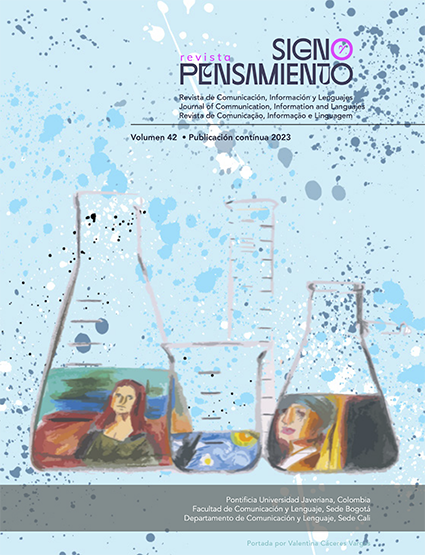Abstract
Considering that representation and language are inseparable from materiality, it is proposed an analysis developed from the studies of Science, Technology and Society, to be applied to the study of cinematographic films. Thus, an exploratory analysis of Patricio Guzmán's documentary El botón de nácar is presented from a sociomaterial perspective. The aim is to expose the agential materiality and the actors that are deployed, in order to analyze the film on the basis of this identification. Memory, its construction and questioning emerge as inseparable elements of the actors that take place.
Barad, K. (2007). Agential Realism: How Material-Discursive Practice Matter. En Meeting the Universe Halfway. Quantum Physics and the Entanglement of Matter and Meaning (pp. 132-186). Duke University Press. https://doi.org/10.2307/j.ctv12101zq.8
Bennett, J. (2022). Materia vibrante. Una ecología política de las cosas. Caja Negra.
Blaine, P. (2015). La representación de la ausencia: el documental de posdictadura de Patricio Guzmán. En A. Traverso y T. F. Crowder-Taraborrelli (eds.), El documental político en Argentina, Chile y Uruguay. De los años cincuenta a la década del dos mil. LOM Ediciones.
Cabello, C. (2022). La invención de la lesbiana oscura en la ficción televisiva: narrativa y afectos en Cárcel de Mujeres. Aisthesis, (72), 254-281. http://www.scielo.cl/scielo.php?script=sci_arttext&pid=S0718-71812022000200254
Colectivo Materia. (2022). Coordenadas para una estética materialista posthumana situada. Aisthesis, (72), 6-9. http://www.scielo.cl/scielo.php?script=sci_arttext&pid=S0718-71812022000200006
De la Fuente, E. (2020). BOTH-AND: on the need for a ‘textural’sociology of art. Caderno CrH, 32, 475-490.
Deleuze, G. (2011). Cine II. Los signos del movimiento y el tiempo. Cactus.
Fausto, J. (2023) La cosmopolitica de los animales. Editorial Cactus.
Figueroa, J. S. (2020). Landscapes of Extraction and the Memories of Extinction in Patricio Guzmán’s Nostalgia de la luz and El botón de nácar. Ecozon@: European Journal of Literature, Culture and Environment, 11(1), 152-169.
Grillo, S. (2020). Patricio Guzmán y la (est)ética del agua. Fotocinema: revista científica de cine y fotografía, (20), 15-28.
Haraway, D. (2017). Manifiesto de las especies de compañía. Perros, gentes y otredades significativas. Bocavulvaria ediciones.
Haraway, D. (2019). Seguir con el problema. Editorial Consonni.
Latour, B. (1996). Aramis or the Love of Technology. Harvard University Press.
Latour, B. (2008) Reensamblar lo social. Una introducción a la teoría del actor-red. Editorial Manantial.
Latour, B. (2013) Investigación sobre los modos de existencia. Una antropología de los modernos. Paidós.
Latour, B. (2017). ¿Es la geo-logía el nuevo paraguas de todas las ciencias? Humus-editores.
Latour, B. y Hermant, E. (2010). Paris ciudad invisible (Publicado originalmente en 1998). http://www.bruno-latour.fr/virtual/index.html
Le Breton, D. (2002). Antropología del cuerpo y modernidad. Nueva Visión.
Myers, N. (2017). Becoming Sensor in Sentient Worlds: A More- than-natural History of a Black Oak Savannah. En Bakke, G y Peterson, M. (eds.), Between Matter and Method. Encounters in Anthropology and Art. Bloomsbury.
Padilla, P. (s. f.). Diez indicios en El botón de nácar [Tesis doctoral]. Universidad de Buenos Aires, Argentina. http://conti.derhuman.jus.gov.ar/2018/01/seminario/mesa_26/pachilla_mesa_26.pdf
Sadek, I. (2013). Memoria espacializada y arqueología del presente en el cine de Patricio Guzmán. Revista Cine Documental, (8), 28-71. https://revista.cinedocumental.com.ar/memoria-espacializada-y-arqueologia-del-presente-en-el-cine-de-patricio-guzman/
Sanz, Á. M. (2021). Nostalgia de la Unidad Popular. Evolución de la forma cinematográfica en la obra de Patricio Guzmán. Kamchatka. Revista de análisis cultural, (17), 271-297.
Silva, G. y Flores, P. (2015). El recorrido de la teoría del actor red en Chile. I Congreso Latinoamericano de Teoría Social, Instituto de Investigaciones Gino Germani. Universidad de Buenos Aires, Argentina.
Vitullo, J. (2013). “Nostalgia de la luz” de Patricio Guzmán: el cine como máquina del tiempo. Kamchatka. Revista de Análisis Cultural, (2), 179-192.

This work is licensed under a Creative Commons Attribution 4.0 International License.
Copyright (c) 2023 Camila Alcaíno Monsalves


